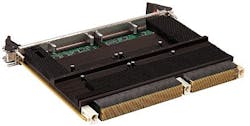Northrop Grumman chooses Curtiss-Wright digital radio equipment for Navy InTop program
CHARLOTTE, N.C., 26 April 2013. Shipboard electronics experts at the Northrop Grumman Corp. Electronic Systems sector in Linthicum, Md., needed an integrated embedded digital radio frequency memory (DRFM) system for use in the U.S. Navy's Integrated Topside (InTop) program. They found their solution from Curtiss-Wright Controls Inc. in Charlotte, N.C.
Curtiss-Wright Controls will supply rugged COTS single-board computers and other embedded computing modules to Northrop Grumman. "Our high performance, rugged open standards processor modules are ideal for this affordable, scalable open architecture RF sensor system," says Tom Quinly, president of Curtiss-Wright Controls.
The initial contract to Curtiss Wright is worth more than $1 million, and with options could be worth more than $50 million, Curtiss-Wright officials say.
Curtiss-Wright's DRFM technology, which integrates seamlessly with Northrop Grumman's system architecture, is based on high-performance open standards COTS and modified COTS (MCOTS) processor modules including the Curtiss-Wright Controls Defense Solutions business group's VPX6-185, VPX6-1957, VPX6-215, XMC-FPGA05D, FusionXF, RS485-MOD2, Champ-DRFM, and CHAMP-AV8 products, company officials say.
Curtiss-Wright's wide-bandwidth DRFM solution supports the high speed interconnects and optimized size/weight/power (SWaP) characteristics required to meet the performance needs of the InTop program.
InTop combines electronic warfare (EW), radar, information operations (IO) and communications capabilities. Its integrated, multifunctional, multibeam topside aperture features a modular, open radio frequency (RF) architecture; software-defined functionality; and synchronization and optimization of RF functions for electromagnetic interference (EMI) mitigation.
For more information contact Curtiss-Wright Controls online at www.cwcontrols.com, Northrop Grumman Electronic Systems at www.northropgrumman.com, or the Office of Naval Research at www.onr.navy.mil.

